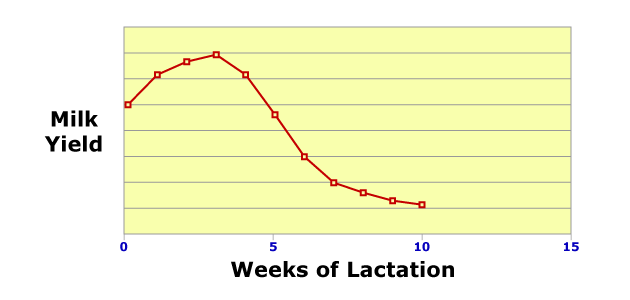Previous Page | Right click this page to print.
Lactation of the Ewe
Milk production. This is kind of the standard curve that you’d see if you’d plot out lactation in a ewe up through 10 weeks and it's kind of going to go down here.
 But we have a peak that occurs somewhere
around 4-5 weeks and after that time it goes down. I don’t have
any units here, but what do you suppose a good milk producing ewe would
be producing at its peak at this time? 4-8 lbs is kind of what we are
talking about here. Good producing ewes are going to be up there closer
to 8 lbs, lesser producing, singles, twins, what have you. In situations
where they milk sheep, in most cases, they’ll leave the ewes and
lambs together until about, where would that be, about 30 days, 5 weeks,
somewhere around out in here. Then, they wean and then they’ll milk
through the rest of the production curve. Some operations will separate
ewes and lambs, let the ewes and lambs run together at night, separate
the ewes and lambs during the day, milk before they turn out in the morning,
milk in the afternoon or evening when they bring them in. That’s
going to vary, but for most part though, they’re milking and taking
advantage of this side of the production curve in situations where they
do milk sheep at sheep dairies.
But we have a peak that occurs somewhere
around 4-5 weeks and after that time it goes down. I don’t have
any units here, but what do you suppose a good milk producing ewe would
be producing at its peak at this time? 4-8 lbs is kind of what we are
talking about here. Good producing ewes are going to be up there closer
to 8 lbs, lesser producing, singles, twins, what have you. In situations
where they milk sheep, in most cases, they’ll leave the ewes and
lambs together until about, where would that be, about 30 days, 5 weeks,
somewhere around out in here. Then, they wean and then they’ll milk
through the rest of the production curve. Some operations will separate
ewes and lambs, let the ewes and lambs run together at night, separate
the ewes and lambs during the day, milk before they turn out in the morning,
milk in the afternoon or evening when they bring them in. That’s
going to vary, but for most part though, they’re milking and taking
advantage of this side of the production curve in situations where they
do milk sheep at sheep dairies.
Milk production does peak at about 3-4 weeks; production 4-8 lbs per day. Ewes with twins don’t produce twice as much milk, about 20-40% more than ewes with singles. We don’t really have a lot of good data on ewes with triplets, what kind of a requirement they have. I know one thing, you really have to feed them a lot if you’re going to get them to raise them. You really have to keep that protein up there. You have to feed them a lot of grain. And just really push them hard to get enough milk to produce, for them, to raise triplet lambs.
How common is triplets? Well, depending upon if you have some of these prolific genes in your flock. For instance Finn, Finn breeding or we have Polypays here at Oregon State University and they’ll drop well over 200%, so we get a lot of triplets. We have some ewes where we’re trying to, we have some Friesian breeding in them. And Friesian are the breeds that they milk in Europe. And so we have some Friesian breeding in them and we’re trying to get them to produce milk to raise these triplets. In fact, I think we’re going to be milking some sheep this year out at the sheep unit as part of this evaluation of the Friesian, progeny tests and things like that.
What is the requirement for lactation? Their intake is going to run about 4.5% of the body weight, as I said about 4 lbs of TDN, 6.6 megacalories ME per day and nearly that 1 lb of crude protein per day, that would be for twins.
Ewe's milk.
Dry Matter |
18.2% |
Fat |
7.0% (5-10%) |
Protein |
4.5% |
Lactose |
4.8% |
Calcium |
0.2% |
I put this in here because one of the things that many operations do,
not so much in this country, but in European countries where they do milk
the sheep, they’ll separate, they’ll take the ewes away from
the lambs or the lambs away from the ewes and raise them on milk replacer.
And of course, ewe's milk has a different composition than cow's milk
from the standpoint of higher fat. It can vary from, this particular reference
list, at 7.0%, but with a 5-10% variation in fat composition. Protein.
Lactose is going to be lower than cow's milk. And this gives you a value
for calcium. One of the problems you’ll encounter if you try and
raise lambs on cow's milk is they’re not going to do very well because
of the fat and the lactose levels that they contain and the differences.
You need to have one formulated for lambs if you’re going to be
successful in raising these lambs on milk replacer.
Previous Page | Right click this page to print.